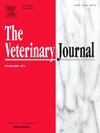自然感染免疫丝虫犬的“慢杀”治疗方案及血清NT-proBNP和血浆d -二聚体作为该感染的生物标志物的评估
IF 3.1
2区 农林科学
Q1 VETERINARY SCIENCES
引用次数: 0
摘要
本研究评估了“慢杀”方案(伊维菌素和强力霉素)对犬免疫Dirofilaria感染的疗效,以及这些病例中NT-proBNP和d -二聚体的生物标志物价值。采用快速抗原检测犬是否存在心丝虫,并于第0 (T0)、第90 (T90)和第180 (T180)天采集血液样本。根据临床症状将犬分为三组:无症状(GASX)、中度(GMODERATE)和重度(GSEVERE)。T0时,GASX组和GMODERATE组NT-proBNP水平在参考值范围内,但GSEVERE组NT-proBNP水平升高,且显著高于GASX组(p <; 0.05)。各组d -二聚体水平均在参考范围内,各组间差异无统计学意义(p >; 0.05)。T90时,NT-proBNP仅在GASX组保持在参考值范围内,各组间差异无统计学意义(p >; 0.05)。而GMODERATE和GSEVERE组d -二聚体水平升高,显著高于GASX组(p <; 0.05)。T180时,所有组NT-proBNP均升高,GMODERATE组(p <; 0.05)和GSEVERE组(p <; 0.01)与GASX组相比显著升高。d -二聚体在所有组中均有所下降,但仍高于参考值,GMODERATE组(p <; 0.05)和GSEVERE组(p <; 0.001)的d -二聚体明显高于GASX组。“慢杀”治疗并没有降低NT-proBNP和d -二聚体水平,考虑到成人的长期滞留,这表明心脏和抗血栓治疗可能是必要的。考虑到临床症状的严重程度与NT-proBNP和d -二聚体水平之间的关系,它们有可能在兽医实践中作为心虫感染犬的预后标志物。本文章由计算机程序翻译,如有差异,请以英文原文为准。
"Slow kill" treatment protocol in naturally infected dogs with Dirofilaria immitis and assessment of serum NT-proBNP and plasma D-dimer as biomarkers of this infection
This study assessed the efficacy of the "slow kill" protocol (ivermectin and doxycycline) on Dirofilaria immitis infection in dogs and the biomarker value of NT-proBNP and D-dimer in these cases. Dogs were tested for heartworm presence using a rapid antigen test, and blood samples were collected on days: 0 (T0), 90 (T90), and 180 (T180). Dogs were divided into three groups based on clinical symptoms: asymptomatic (GASX), moderate (GMODERATE), and severe (GSEVERE). At T0, NT-proBNP levels were within the reference values in GASX and GMODERATE groups but elevated in GSEVERE and significantly (p < 0.05) higher than in GASX. D-dimer levels were within the reference range in all groups without significant (p > 0.05) differences among them. At T90, NT-proBNP remained within the reference values only in GASX and was not significantly different (p > 0.05) among groups. However, D-dimer levels increased in GMODERATE and GSEVERE, being significantly (p < 0.05) higher than in GASX group. At T180, NT-proBNP was elevated in all groups, being significantly higher in GMODERATE (p < 0.05) and GSEVERE (p < 0.01) compared to GASX. D-dimer decreased across all groups but remained above the reference values, being significantly higher in GMODERATE (p < 0.05) and GSEVERE (p < 0.001) than in GASX. The "slow kill" treatment did not reduce NT-proBNP and D-dimer levels, having in mind long retention of adults, suggesting that cardiac and antithrombotic therapies may be necessary. Considering the relationship between the severity of clinical pictures and the levels of NT-proBNP and D-dimer, they have potential as prognostic markers in veterinary practice for heartworm-infected dogs.
求助全文
通过发布文献求助,成功后即可免费获取论文全文。
去求助
来源期刊

Veterinary journal
农林科学-兽医学
CiteScore
4.10
自引率
4.50%
发文量
79
审稿时长
40 days
期刊介绍:
The Veterinary Journal (established 1875) publishes worldwide contributions on all aspects of veterinary science and its related subjects. It provides regular book reviews and a short communications section. The journal regularly commissions topical reviews and commentaries on features of major importance. Research areas include infectious diseases, applied biochemistry, parasitology, endocrinology, microbiology, immunology, pathology, pharmacology, physiology, molecular biology, immunogenetics, surgery, ophthalmology, dermatology and oncology.
 求助内容:
求助内容: 应助结果提醒方式:
应助结果提醒方式:


